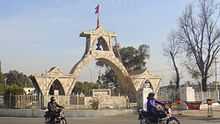Martyrs of Nepal
From Wikipedia, the free encyclopedia

Shahid (Martyr) Gate, Kathmandu
Martyr (Nepali: शहिद; Shahid) in Nepal is a term for some one who suffers is killed while making contributions for the welfare of the country or society. The term was originally used for individuals who died while opposing the Rana Regime which was in place in the Kingdom of Nepal from 1846 until 1951. [1] Lakhan Thapa is regarded as the first martyr of Nepal. [2]
Original Martyrs
- Rebelled against Jung Bahadur Rana
(martyred in 1877 — "first martyr")
- Lakhan Thapa Magar
- Rebelled against Juddha Shamsher Jung Bahadur Rana
(martyred in 1941 — represented in the Shahid Gate)
Note: Ramhari Sharma, founder of Nepal Praja Parishad, was not given the death sentence as he was a Brahmin, and is often called a "living martyr." [3]
Legacy
- Martyr's day is celebrated every year on Magh 16 (January 29). Martyr's week is Magh 10-16 (January 23-29). [4]
- Shahid Gate is a monument to the martyrs in Kathmandu. It is customary for Prime Ministers and other officials to visit the monument after taking oaths of office
- Martyr's Memorial A-Division League is the top division of the All Nepal Football Association.
- Dashrath Stadium, Nepal's national stadium is named after Dashrath Chand.
- Many streets and parks in the country are named after the martyrs.
See also
- Lakhan Thapa
- Dashrath Chand
- Dharma Bhakta Mathema
- Shukraraj Shastri Joshi
- Gangalal Shrestha
- Nepal Praja Parishad
References
- ↑ http://www.geocities.ws/gknepaleyn/data/martyrs.html
- ↑ http://www.nepalitimes.com.np/issue/2001/06/15/FromtheNepaliPress/9004
- ↑ http://www.thehimalayantimes.com/fullNews.php?headline=Living+martyr+Sharma+dies+at+96&NewsID=350441
- ↑ http://www.nepalnews.com/home/index.php/news/1/16321-martyrs-day-being-celebrated.html
This article is issued from Wikipedia. The text is available under the Creative Commons Attribution/Share Alike; additional terms may apply for the media files.